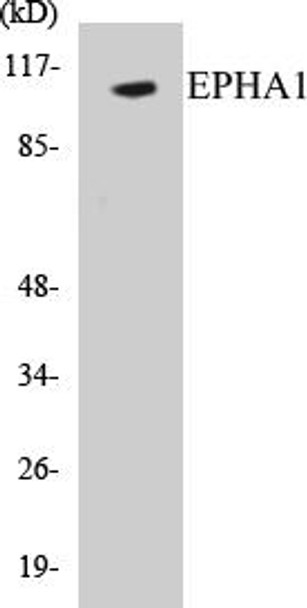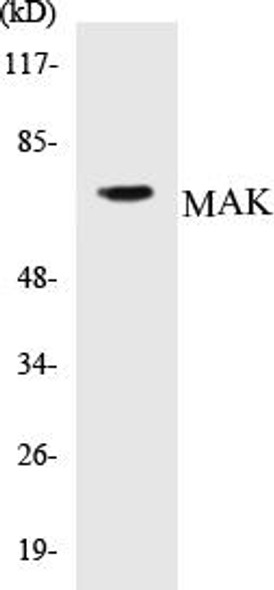Description
EPHA1 Colorimetric Cell-Based ELISA Kit
The EPHA1 Colorimetric Cell-Based ELISA Kit is a cutting-edge tool designed for the accurate detection of EPHA1 levels in cell lysate samples. This innovative kit offers high sensitivity and specificity, ensuring precise and reproducible results for your research needs.EPHA1, a member of the ephrin receptor family, plays a crucial role in cell signaling and is involved in various cellular processes such as cell adhesion, migration, and proliferation. Dysregulation of EPHA1 has been linked to cancer, neurological disorders, and inflammatory diseases, making it a valuable biomarker for studying these conditions and potential therapeutic targets.
With the EPHA1 Colorimetric Cell-Based ELISA Kit, researchers can confidently assess EPHA1 levels in cell lysates, allowing for a better understanding of its role in disease pathogenesis and the development of targeted treatments. Upgrade your research capabilities with this advanced ELISA kit from AssayGenie.
| Product Name: | EPHA1 Colorimetric Cell-Based ELISA |
| Product Code: | CBCAB00637 |
| ELISA Type: | Cell-Based |
| Target: | EPHA1 |
| Reactivity: | Human |
| Dynamic Range: | > 5000 Cells |
| Detection Method: | Colorimetric 450 nmStorage/Stability:4°C/6 Months |
| Format: | 96-Well Microplate |
The EPHA1 Colorimetric Cell-Based ELISA Kit is a convenient, lysate-free, high throughput and sensitive assay kit that can detect EPHA1 protein expression profile in cells. The kit can be used for measuring the relative amounts of EPHA1 in cultured cells as well as screening for the effects that various treatments, inhibitors (ie siRNA or chemicals), or activators have on EPHA1.
Qualitative determination of EPHA1 concentration is achieved by an indirect ELISA format. In essence, EPHA1 is captured by EPHA1-specific primary antibodies while the HRP-conjugated secondary antibodies bind the Fc region of the primary antibody. Through this binding, the HRP enzyme conjugated to the secondary antibody can catalyze a colorimetric reaction upon substrate addition. Due to the qualitative nature of the Cell-Based ELISA, multiple normalization methods are needed:
| 1. | A monoclonal antibody specific for human GAPDH is included to serve as an internal positive control in normalizing the target absorbance values. |
| 2. | Following the colorimetric measurement of HRP activity via substrate addition, the Crystal Violet whole-cell staining method may be used to determine cell density. After staining, the results can be analysed by normalizing the absorbance values to cell amounts, by which the plating difference can be adjusted. |
| Database Information: | Gene ID: 2041, UniProt ID: P21709, OMIM: 179610, Unigene: Hs.89839 |
| Gene Symbol: | EPHA1 |
| Sub Type: | None |
| UniProt Protein Function: | EphA1: a receptor tyrosine kinase. Receptor for members of the ephrin-A family. Binds with a low affinity to ephrin-A1. The Eph receptor tyrosine kinase family, the largest in the tyrosine kinase group, has fourteen members. They bind membrane-anchored ligands, ephrins, at sites of cell-cell contact, regulating the repulsion and adhesion of cells that underlie the establishment, maintenance, and remodeling of patterns of cellular organization. Eph signals are particularly important in regulating cell adhesion and cell migration during development, axon guidance, homeostasis and disease. EphA receptors bind to GPI-anchored ephrin-A ligands, while EphB receptors bind to ephrin-B proteins that have a transmembrane and cytoplasmic domain. Interactions between EphB receptor kinases and ephrin-B proteins transduce signals bidirectionally, signaling to both interacting cell types. Eph receptors and ephrins also regulate the adhesion of endothelial cells and are required for the remodeling of blood vessels. Misexpressed in several cancers, including upregulation in head and neck cancer, and downregulation in invasive breast cancer cell lines and glioblastoma |
| UniProt Protein Details: | Protein type:Membrane protein, integral; EC 2.7.10.1; Protein kinase, tyrosine (receptor); Kinase, protein; Protein kinase, TK; TK group; Eph family Chromosomal Location of Human Ortholog: 7q34 Cellular Component: integral to plasma membrane; plasma membrane Molecular Function:ATP binding; protein kinase activity; protein kinase binding; transmembrane-ephrin receptor activity Biological Process: angiogenesis; cell surface receptor linked signal transduction; ephrin receptor signaling pathway; negative regulation of cell migration; negative regulation of protein kinase activity; peptidyl-tyrosine phosphorylation; positive regulation of angiogenesis; positive regulation of cell migration; positive regulation of cell proliferation; positive regulation of cell-matrix adhesion; positive regulation of stress fiber formation; protein amino acid autophosphorylation; regulation of GTPase activity; somatic stem cell maintenance |
| NCBI Summary: | This gene belongs to the ephrin receptor subfamily of the protein-tyrosine kinase family. EPH and EPH-related receptors have been implicated in mediating developmental events, particularly in the nervous system. Receptors in the EPH subfamily typically have a single kinase domain and an extracellular region containing a Cys-rich domain and 2 fibronectin type III repeats. The ephrin receptors are divided into 2 groups based on the similarity of their extracellular domain sequences and their affinities for binding ephrin-A and ephrin-B ligands. This gene is expressed in some human cancer cell lines and has been implicated in carcinogenesis. [provided by RefSeq, Jul 2008] |
| UniProt Code: | P21709 |
| NCBI GenInfo Identifier: | 317373566 |
| NCBI Gene ID: | 2041 |
| NCBI Accession: | P21709.4 |
| UniProt Secondary Accession: | P21709,Q15405, A1L3V3, B5A966, B5A967, |
| UniProt Related Accession: | P21709 |
| Molecular Weight: | 51,069 Da |
| NCBI Full Name: | Ephrin type-A receptor 1 |
| NCBI Synonym Full Names: | EPH receptor A1 |
| NCBI Official Symbol: | EPHA1 |
| NCBI Official Synonym Symbols: | EPH; EPHT; EPHT1 |
| NCBI Protein Information: | ephrin type-A receptor 1 |
| UniProt Protein Name: | Ephrin type-A receptor 1 |
| UniProt Synonym Protein Names: | EPH tyrosine kinase; EPH tyrosine kinase 1; Erythropoietin-producing hepatoma receptor; Tyrosine-protein kinase receptor EPH |
| Protein Family: | Ephrin type-A receptor |
| UniProt Gene Name: | EPHA1 |
| UniProt Entry Name: | EPHA1_HUMAN |
| Component | Quantity |
| 96-Well Cell Culture Clear-Bottom Microplate | 2 plates |
| 10X TBS | 24 mL |
| Quenching Buffer | 24 mL |
| Blocking Buffer | 50 mL |
| 15X Wash Buffer | 50 mL |
| Primary Antibody Diluent | 12 mL |
| 100x Anti-Phospho Target Antibody | 60 µL |
| 100x Anti-Target Antibody | 60 µL |
| Anti-GAPDH Antibody | 60 µL |
| HRP-Conjugated Anti-Rabbit IgG Antibody | 12 mL |
| HRP-Conjugated Anti-Mouse IgG Antibody | 12 mL |
| SDS Solution | 12 mL |
| Stop Solution | 24 mL |
| Ready-to-Use Substrate | 12 mL |
| Crystal Violet Solution | 12 mL |
| Adhesive Plate Seals | 2 seals |
The following materials and/or equipment are NOT provided in this kit but are necessary to successfully conduct the experiment:
- Microplate reader able to measure absorbance at 450 nm and/or 595 nm for Crystal Violet Cell Staining (Optional)
- Micropipettes with capability of measuring volumes ranging from 1 µL to 1 ml
- 37% formaldehyde (Sigma Cat# F-8775) or formaldehyde from other sources
- Squirt bottle, manifold dispenser, multichannel pipette reservoir or automated microplate washer
- Graph paper or computer software capable of generating or displaying logarithmic functions
- Absorbent papers or vacuum aspirator
- Test tubes or microfuge tubes capable of storing ≥1 ml
- Poly-L-Lysine (Sigma Cat# P4832 for suspension cells)
- Orbital shaker (optional)
- Deionized or sterile water
*Note: Protocols are specific to each batch/lot. For the correct instructions please follow the protocol included in your kit.
| Step | Procedure |
| 1. | Seed 200 µL of 20,000 adherent cells in culture medium in each well of a 96-well plate. The plates included in the kit are sterile and treated for cell culture. For suspension cells and loosely attached cells, coat the plates with 100 µL of 10 µg/ml Poly-L-Lysine (not included) to each well of a 96-well plate for 30 minutes at 37°C prior to adding cells. |
| 2. | Incubate the cells for overnight at 37°C, 5% CO2. |
| 3. | Treat the cells as desired. |
| 4. | Remove the cell culture medium and rinse with 200 µL of 1x TBS, twice. |
| 5. | Fix the cells by incubating with 100 µL of Fixing Solution for 20 minutes at room temperature. The 4% formaldehyde is used for adherent cells and 8% formaldehyde is used for suspension cells and loosely attached cells. |
| 6. | Remove the Fixing Solution and wash the plate 3 times with 200 µL 1x Wash Buffer for five minutes each time with gentle shaking on the orbital shaker. The plate can be stored at 4°C for a week. |
| 7. | Add 100 µL of Quenching Buffer and incubate for 20 minutes at room temperature. |
| 8. | Wash the plate 3 times with 1x Wash Buffer for 5 minutes each time. |
| 9. | Add 200 µL of Blocking Buffer and incubate for 1 hour at room temperature. |
| 10. | Wash 3 times with 200 µL of 1x Wash Buffer for 5 minutes each time. |
| 11. | Add 50 µL of 1x primary antibodies (Anti-EPHA1 Antibody and/or Anti-GAPDH Antibody) to the corresponding wells, cover with Parafilm and incubate for 16 hours (overnight) at 4°C. If the target expression is known to be high, incubate for 2 hours at room temperature. |
| 12. | Wash 3 times with 200 µL of 1x Wash Buffer for 5 minutes each time. |
| 13. | Add 50 µL of 1x secondary antibodies (HRP-Conjugated AntiRabbit IgG Antibody or HRP-Conjugated Anti-Mouse IgG Antibody) to corresponding wells and incubate for 1.5 hours at room temperature. |
| 14. | Wash 3 times with 200 µL of 1x Wash Buffer for 5 minutes each time. |
| 15. | Add 50 µL of Ready-to-Use Substrate to each well and incubate for 30 minutes at room temperature in the dark. |
| 16. | Add 50 µL of Stop Solution to each well and read OD at 450 nm immediately using the microplate reader. |
(Additional Crystal Violet staining may be performed if desired – details of this may be found in the kit technical manual.)






